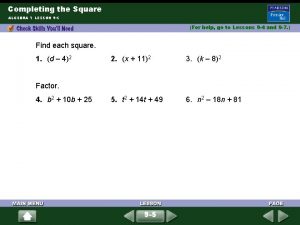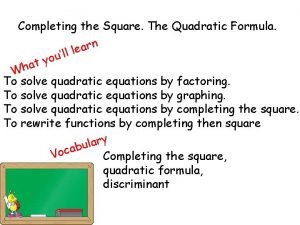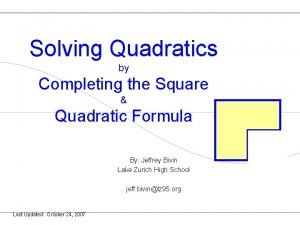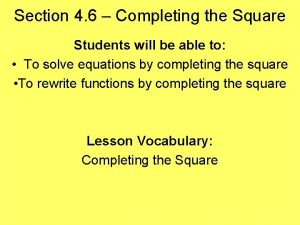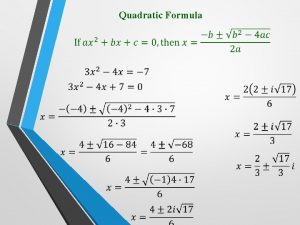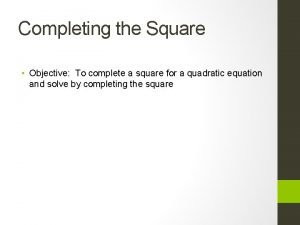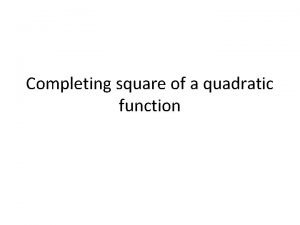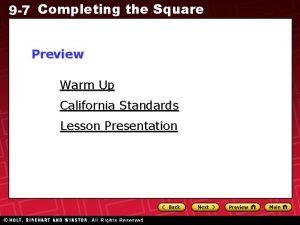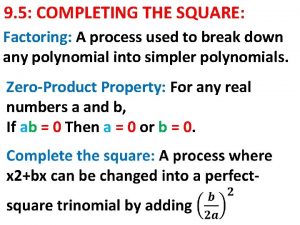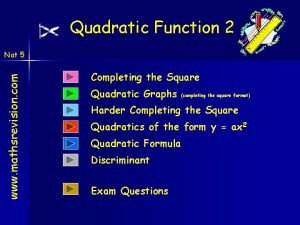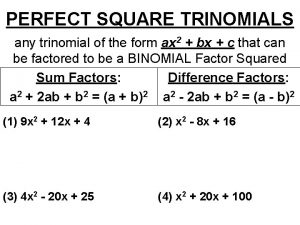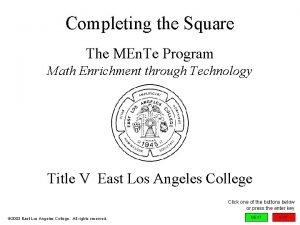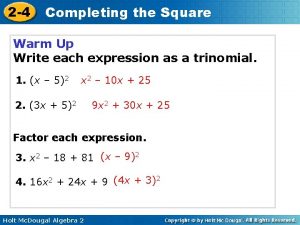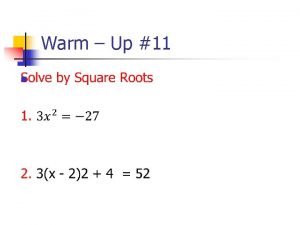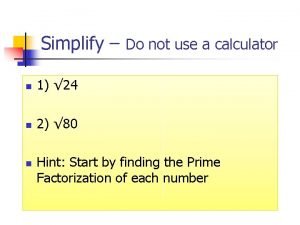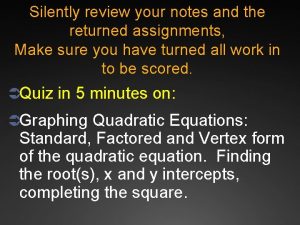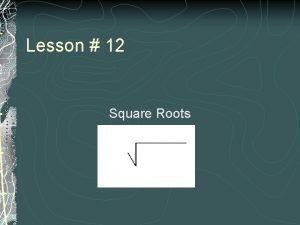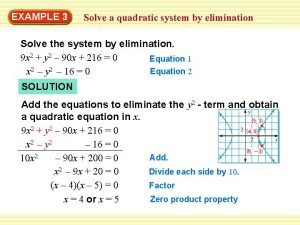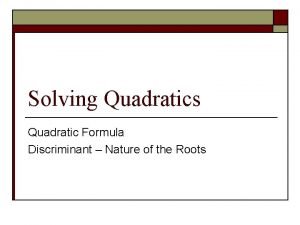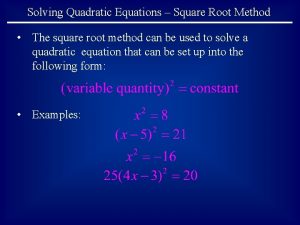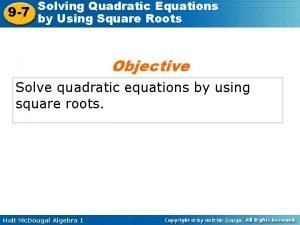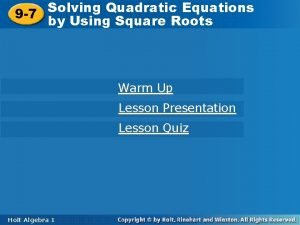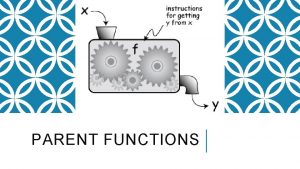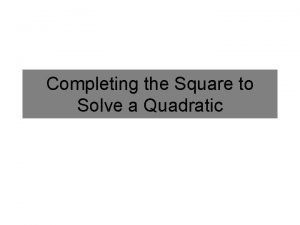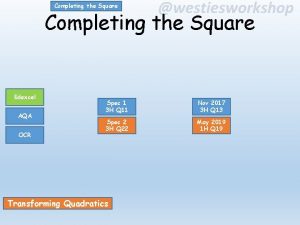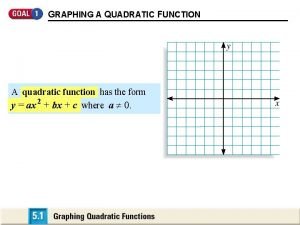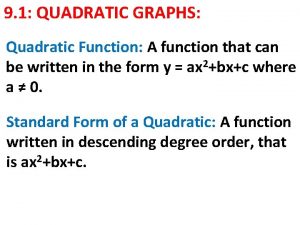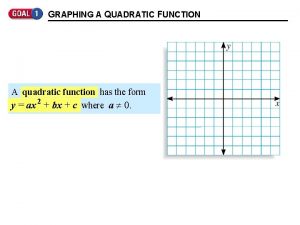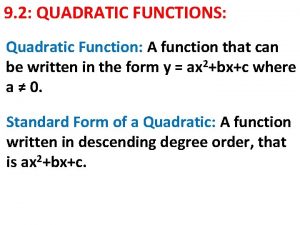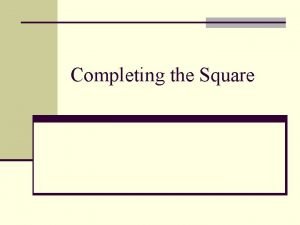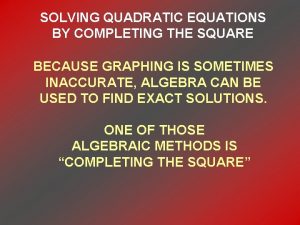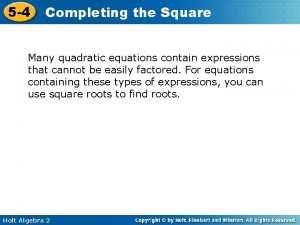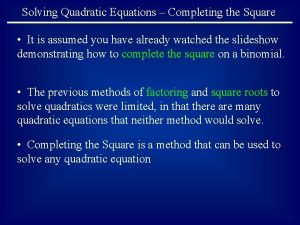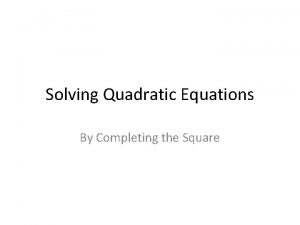Completing square of a quadratic function Warm Up









































- Slides: 41

Completing square of a quadratic function

Warm Up Write each expression as a trinomial. 1. (x – 5)2 2. (3 x + 5)2 x 2 – 10 x + 25 9 x 2 + 30 x + 25 Factor each expression. 3. x 2 – 18 + 81 (x – 9)2 4. 16 x 2 + 24 x + 9 (4 x + 3)2

Objectives Solve quadratic equations by completing the square. Write quadratic equations in vertex form.

Vocabulary completing the square

Many quadratic equations contain expressions that cannot be easily factored. For equations containing these types of expressions, you can use square roots to find roots.

Reading Math Read as “plus or minus square root of a. ”

Example 1 A: Solving Equations by Using the Square Root Property Solve the equation. 4 x 2 + 11 = 59 4 x 2 = 48 x 2 = 12 Subtract 11 from both sides. Divide both sides by 4 to isolate the square term. Take the square root of both sides. Simplify.

Example 1 A Continued Check Use a graphing calculator.

Example 1 B: Solving Equations by Using the Square Root Property Solve the equation. x 2 + 12 x + 36 = 28 (x + 6)2 = 28 Factor the perfect square trinomial Take the square root of both sides. Subtract 6 from both sides. Simplify.

Example 1 B Continued Check Use a graphing calculator.

Check It Out! Example 1 a Solve the equation. 4 x 2 – 20 = 5 4 x 2 = 25 Add 20 to both sides. Divide both sides by 4 to isolate the square term. Take the square root of both sides. Simplify.

Check It Out! Example 1 a Continued Check Use a graphing calculator.

Check It Out! Example 1 b Solve the equation. x 2 + 8 x + 16 = 49 (x + 4)2 = 49 Factor the perfect square trinomial. Take the square root of both sides. x = – 4 ± Subtract 4 from both sides. x = – 11, 3 Simplify.

Check It Out! Example 1 b Continued Check Use a graphing calculator.

The methods in the previous examples can be used only for expressions that are perfect squares. However, you can use algebra to rewrite any quadratic expression as a perfect square. You can use algebra tiles to model a perfect square trinomial as a perfect square. The area of the square at right is x 2 + 2 x + 1. Because each side of the square measures x + 1 units, the area is also (x + 1), or (x + 1)2. This shows that (x + 1)2 = x 2 + 2 x + 1.

If a quadratic expression of the form x 2 + bx cannot model a square, you can add a term to form a perfect square trinomial. This is called completing the square.

The model shows completing the square for x 2 + 6 x by adding 9 unit tiles. The resulting perfect square trinomial is x 2 + 6 x + 9. Note that completing the square does not produce an equivalent expression.

Example 2 A: Completing the Square Complete the square for the expression. Write the resulting expression as a binomial squared. x 2 – 14 x + Find . Add. x 2 – 14 x + 49 Factor. (x – 7)2 Check Find the square of the binomial. (x – 7)2 = (x – 7) = x 2 – 14 x + 49

Example 2 B: Completing the Square Complete the square for the expression. Write the resulting expression as a binomial squared. x 2 + 9 x + Find Add. Factor. . Check Find the square of the binomial.

Check It Out! Example 2 a Complete the square for the expression. Write the resulting expression as a binomial squared. x 2 + 4 x + Find x 2 + 4 x + 4 (x + 2)2 Check . Add. Factor. Find the square of the binomial. (x + 2)2 = (x + 2) = x 2 + 4 x + 4

Check It Out! Example 2 b Complete the square for the expression. Write the resulting expression as a binomial squared. x 2 – 4 x + Find x 2 – 4 x + 4 (x – 2)2 Check . Add. Factor. Find the square of the binomial. (x – 2)2 = (x – 2) = x 2 – 4 x + 4

Check It Out! Example 2 c Complete the square for the expression. Write the resulting expression as a binomial squared. x 2 + 3 x + Find Add. Factor. . Check Find the square of the binomial.

You can complete the square to solve quadratic equations.

Example 3 A: Solving a Quadratic Equation by Completing the Square Solve the equation by completing the square. x 2 = 12 x – 20 x 2 – 12 x = – 20 x 2 – 12 x + = – 20 + Collect variable terms on one side. Set up to complete the square. Add x 2 – 12 x + 36 = – 20 + 36 to both sides. Simplify.

Example 3 A Continued (x – 6)2 = 16 Factor. Take the square root of both sides. x – 6 = ± 4 x – 6 = 4 or x – 6 = – 4 x = 10 or x = 2 Simplify. Solve for x.

Example 3 B: Solving a Quadratic Equation by Completing the Square Solve the equation by completing the square. 18 x + 3 x 2 = 45 x 2 + 6 x = 15 x 2 + 6 x + = 15 + Divide both sides by 3. Set up to complete the square. Add x 2 + 6 x + 9 = 15 + 9 to both sides. Simplify.

Example 3 B Continued (x + 3)2 = 24 Factor. Take the square root of both sides. Simplify.

Check It Out! Example 3 a Solve the equation by completing the square. x 2 – 2 = 9 x Collect variable terms on one side. x 2 – 9 x = 2 x 2 – 9 x + =2+ Set up to complete the square. Add to both sides. Simplify.

Check It Out! Example 3 a Continued Factor. 9 x – = ± 89 4 2 x= 9 ± 89 2 Take the square root of both sides. Simplify.

Check It Out! Example 3 b Solve the equation by completing the square. 3 x 2 – 24 x = 27 Divide both sides by 3. x 2 – 8 x = 9 x 2 – 8 x + =9+ Set up to complete the square. Add to both sides. Simplify.

Check It Out! Example 3 b Continued Solve the equation by completing the square. Factor. Take the square root of both sides. Simplify. x – 4 =– 5 or x – 4 = 5 x =– 1 or x = 9 Solve for x.

Recall the vertex form of a quadratic function from lesson 5 -1: f(x) = a(x – h)2 + k, where the vertex is (h, k). You can complete the square to rewrite any quadratic function in vertex form. Helpful Hint In Example 3, the equation was balanced by adding to both sides. Here, the equation is balanced by adding and subtracting side. on one

Example 4 A: Writing a Quadratic Function in Vertex Form Write the function in vertex form, and identify its vertex. f(x) = x 2 + 16 x – 12 f(x)=(x 2 + 16 x + ) – 12 – Set up to complete the square. Add and subtract f(x) = (x + 8)2 – 76 Simplify and factor. Because h = – 8 and k = – 76, the vertex is (– 8, – 76). .

Example 4 A Continued Check Use the axis of symmetry formula to confirm vertex. y = f(– 8) = (– 8)2 + 16(– 8) – 12 = – 76

Example 4 B: Writing a Quadratic Function in Vertex Form Write the function in vertex form, and identify its vertex g(x) = 3 x 2 – 18 x + 7 g(x) = 3(x 2 – 6 x) + 7 Factor so the coefficient of x 2 is 1. g(x) = 3(x 2 – 6 x + Set up to complete the square. )+7– 2 Add . Because is multiplied by 3, you must subtract 3.

Example 4 B Continued g(x) = 3(x – 3)2 – 20 Simplify and factor. Because h = 3 and k = – 20, the vertex is (3, – 20). Check A graph of the function on a graphing calculator supports your answer.

Check It Out! Example 4 a Write the function in vertex form, and identify its vertex f(x) = x 2 + 24 x + 145 f(x) = (x 2 + 24 x + ) + 145 – Set up to complete the square. Add and subtract f(x) = (x + 12)2 + 1 Simplify and factor. Because h = – 12 and k = 1, the vertex is (– 12, 1). .

Check It Out! Example 4 a Continued Check Use the axis of symmetry formula to confirm vertex. y = f(– 12) = (– 12)2 + 24(– 12) + 145 = 1

Check It Out! Example 4 b Write the function in vertex form, and identify its vertex g(x) = 5 x 2 – 50 x + 128 g(x) = 5(x 2 – 10 x) + 128 Factor so the coefficient of x 2 is 1. g(x) = 5(x 2 – 10 x + Set up to complete the square. ) + 128 – Add . Because is multiplied by 5, you must subtract 5.

Check It Out! Example 4 b Continued g(x) = 5(x – 5)2 + 3 Simplify and factor. Because h = 5 and k = 3, the vertex is (5, 3). Check A graph of the function on a graphing calculator supports your answer.

Lesson Quiz 1. Complete the square for the expression x 2 – 15 x +. Write the resulting expression as a binomial squared. Solve each equation. 2. x 2 – 16 x + 64 = 20 3. x 2 – 27 = 4 x Write each function in vertex form and identify its vertex. 5. f(x) = 2 x 2 – 12 x – 27 4. f(x)= x 2 + 6 x – 7 f(x) = (x + 3)2 – 16; f(x) = 2(x – 3)2 – 45; (– 3, – 16) (3, – 45)
 9-5 solving quadratic equations by completing the square
9-5 solving quadratic equations by completing the square Completing the swuare
Completing the swuare When to use quadratic formula vs completing the square
When to use quadratic formula vs completing the square How to use completing the square
How to use completing the square Site:slidetodoc.com
Site:slidetodoc.com Completing the square solver
Completing the square solver Complete square formula
Complete square formula 4-6 completing the square
4-6 completing the square Quadratic function examples with answers
Quadratic function examples with answers Dr frost maths completing the square
Dr frost maths completing the square Completing the square formula
Completing the square formula Completing the square conic sections
Completing the square conic sections 9-5 completing the square form g
9-5 completing the square form g Completing the square examples
Completing the square examples 9-5 completing the square
9-5 completing the square 8-8 practice completing the square
8-8 practice completing the square Completing the square (continued) quiz
Completing the square (continued) quiz Completing the square tutorial
Completing the square tutorial Quadratics nat 5
Quadratics nat 5 Completing the square
Completing the square Perfect square trinomial example
Perfect square trinomial example Dr frost maths
Dr frost maths Completing square program
Completing square program Completing the square (continued)
Completing the square (continued) Completing the square (continued)
Completing the square (continued) Completing the square mathswatch
Completing the square mathswatch Completing square method
Completing square method How to find perfect square
How to find perfect square 2-4 completing the square
2-4 completing the square Completing the square
Completing the square 9-8 completing the square
9-8 completing the square Completing the square
Completing the square Perfect square trinomial calculator
Perfect square trinomial calculator Completing of squares
Completing of squares Lesson 12: completing the square
Lesson 12: completing the square Quadratic quadratic systems examples
Quadratic quadratic systems examples Quadratic formula discriminant
Quadratic formula discriminant Solving quadratic equations by square root property
Solving quadratic equations by square root property 9-7 solving quadratic equations by using square roots
9-7 solving quadratic equations by using square roots 9-7 solving quadratic equations by using square roots
9-7 solving quadratic equations by using square roots Cubic function parent function
Cubic function parent function Function notation warm up
Function notation warm up
